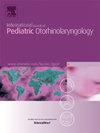父母焦虑和灾难化对儿童扁桃体切除术后阿片类药物消费的影响
IF 1.2
4区 医学
Q3 OTORHINOLARYNGOLOGY
International journal of pediatric otorhinolaryngology
Pub Date : 2025-05-02
DOI:10.1016/j.ijporl.2025.112374
引用次数: 0
摘要
父母心理因素对儿童术后疼痛管理的影响尚不清楚,但很重要。本研究的目的是确定父母焦虑、儿童疼痛灾难化和扁桃体切除术儿童阿片类药物给药之间的关系。这是一项来自四个不同中心的多中心前瞻性队列研究,研究时间为2022年至2023年。所有接受腺扁桃体切除术儿童的父母均被纳入研究。使用状态-特质焦虑量表(STAI)、数字焦虑量表(NAS)和痛苦灾难化量表-父母版(PCS-P)评估父母的焦虑和痛苦灾难化水平。在术后1、3、7、10天收集术后镇痛数据。结果共纳入236例患者。儿童平均年龄为5.1岁(SD为2.8)。平均基线父母PCS-P评分为34.4,NAS评分为6.1。PCS-P和NAS评分越高,术后早期使用阿片类药物的几率越高(POD 1和3 [aOR 1.16, 95% CI[1.03-2.99])。通信延迟儿童(aOR 4.75, 95% CI[2.35-9.59])和幼儿(aOR 1.73, 95% CI[1.45-2.56])术后早期阿片类药物给药也增加(POD1 &;3).结论焦虑程度和灾难化倾向较高的家长术后早期使用阿片类药物的可能性较大。沟通能力有限的儿童更有可能在扁桃体切除术后接受更多的阿片类药物。干预措施,如对父母心理健康的针对性筛查,围手术期咨询,量身定制的疼痛控制方案代表了改善疼痛管理的有希望的途径。本文章由计算机程序翻译,如有差异,请以英文原文为准。
Effect of parental anxiety and catastrophizing on post-tonsillectomy opioid consumption in children
Background
The impact of parental psychological factors on post-operative pain management in children is not well understood, but is important. The aim of this study was to determine the relationship between parental anxiety, pain catastrophizing about child pain, and opioid administration in children undergoing tonsillectomy.
Methods
This was a multicenter prospective cohort study from four different centers between 2022 and 2023. All parents of children undergoing adenotonsillectomy were included. Parental levels of anxiety and pain catastrophizing were assessed using the State-Trait Anxiety inventory (STAI), a Numeric Anxiety Scale (NAS), and the Pain Catastrophizing Scale-Parent Version (PCS-P). Post-operative analgesia data was collected on post-operative days (POD) 1, 3, 7, and 10.
Results
236 patients were included. Mean child age was 5.1 years old (SD 2.8). Mean baseline parental PCS-P score was 34.4 and NAS was 6.1. Higher PCS-P and NAS scores corresponded to increased odds of opioid administration in the early postoperative period (POD 1 and 3 [aOR 1.16, 95 % CI [1.03–2.99])). Children with a communication delay (aOR 4.75, 95 % CI [2.35–9.59]) and young children (aOR 1.73, 95 % CI [1.45–2.56]) also had increased opioid administration in the early postoperative period (POD1 & 3).
Conclusion
Parents who have higher anxiety and tendencies to catastrophize are more likely to administer opioids early in the postoperative period. Children with limited communication skills are more likely to receive greater amounts of opioids after tonsillectomy. Interventions such as targeted screening for parental mental health, peri-operative counseling, and tailored pain control programs represent promising avenues for improving pain management.
求助全文
通过发布文献求助,成功后即可免费获取论文全文。
去求助
来源期刊
CiteScore
3.20
自引率
6.70%
发文量
276
审稿时长
62 days
期刊介绍:
The purpose of the International Journal of Pediatric Otorhinolaryngology is to concentrate and disseminate information concerning prevention, cure and care of otorhinolaryngological disorders in infants and children due to developmental, degenerative, infectious, neoplastic, traumatic, social, psychiatric and economic causes. The Journal provides a medium for clinical and basic contributions in all of the areas of pediatric otorhinolaryngology. This includes medical and surgical otology, bronchoesophagology, laryngology, rhinology, diseases of the head and neck, and disorders of communication, including voice, speech and language disorders.

 求助内容:
求助内容: 应助结果提醒方式:
应助结果提醒方式:


